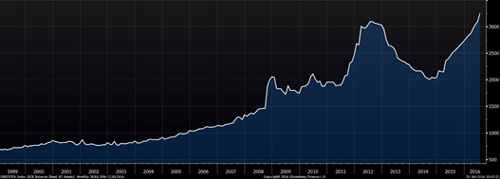What the world needs now, is debt, sweet debt.
Isn’t that how Dionne Warwick’s hit song, written by Burt Bacharach went? Ah, no! It was this:
What the world needs now is love, sweet love / It’s the only thing that there’s just too little of / What the world needs now is love, sweet love / No, not just for some but for everyone.
The song is probably truer now than it was in the mid ‘60s. The world could always use more love. What it doesn’t need any more of today is productive capacity, or stuff. Imagine that:
What the world needs now is stuff, more stuff / It’s the only thing that there’s just too little of.
The world certainly doesn’t need more debt. Economist Richard Duncan reckons total global debt – household, business, financial, and government – is now over $300 trillion. Remember, total debt has actually grown by $57 trillion since 2008, according to a McKinsey study. The private sector paid debt down.
But governments racked it up
And now a team at Standard & Poor’s reckons corporations (mostly in China and the US) will take advantage of low rates to add another $23.6 trillion in debt by 2020. That would take total (measurable) corporate borrowing to $75 trillion – a 50% increase in four years. And governments via central banks?
I’ll get to them in a moment. But ask yourself this: what will be done with all that debt? Who will borrow it? What will they build with it? Who will buy that debt and count it as an asset on the balance sheet or derive income from it? Will the sum total of the world’s productive capacity be added to?
Or do you get another feeling? Do you get the feeling we’re all surfing on a giant illusion of borrowed money? And that there must be a limit to how long this can last? Are government bonds becoming like tulips and tech stocks?
I don’t mean to be melodramatic. But I don’t want to be pedantic either. The Austrian school of economics calls this a credit bubble. It calls it a misallocation of capital, in which real resources (raw materials, labour, and energy) are invested in projects not driven by real demand or organic (and sustainable) economic growth.
Growth for growth’s sake and growth at all costs works more or less like cancer cells multiplying. Growth alone isn’t health. It’s just an uncontrolled increase in quantity until death.
But hey, quantity has a quality all its own, as the saying goes. If the world is awash in material abundance, surely that’s better than suffering from scarcity. What do you think? Too much debt? Or bring it on!
ECB and BoJ take centre stage
On to less philosophical matters. The European Central Bank’s (ECB) monetary policy committee meets today. ECB president Mario Draghi will then host a press conference afterwards. He will likely be asked what the bank is going to do when it runs out of bonds to buy.
It sounds crazy. But it’s true. The ECB is committed to buying €80 billion worth of assets each month under a programme scheduled to conclude in March 2017. The asset purchase programme has fired €1.9 trillion worth of bullets so far. It’s expanded the ECB’s balance sheet to €3.2 trillion. Money for nothing, your bonds for free (albeit with a negative yield).
 Source: Bloomberg
Source: Bloomberg
If you have a printing press and you’re willing to use it, there’s no theoretical limit to how much money you can spend. Well, the only limit is whether there are enough assets for you to buy. Even though it’s expanded its APP to include corporate bonds, the ECB is running out of eligible bonds it can buy under the current rules.
For example, 60% of German government bonds have a yield lower than the ECB’s policy rate of minus 0.4%. Any bond with a yield below the ECB’s policy rate is not eligible for the APP. Yet German government debt is some of the highest quality and most desired debt in Europe.
Surreal debt absurdity
Which reveals the surreal absurdity of this moment in monetary history: central banks are buying debt faster than governments can create it through new borrowing.
If you’re Keynesian, the answer is obvious: more spending and borrowing! Fiscal policy (government spending) to the head of the line please. And as always, first in the queue for trying crazy things that won’t work is Japan.
Japan’s government is expected to inject $190 billion into the economy with a new stimulus measure, we learned over night from Reuters. To prevent recession, Japan is determined to line the pockets of its citizens with money that must be spent. That leads me to a question.
I don’t have an answer to the question but maybe you do. Here it is: how do you get people to spend money when they’d prefer to save it?
If you can answer that question for me, you’ll be ahead of 99% of the rest of the world’s population. You’ll know what’s coming next in Japan. And if you see it in Japan, there’s a good bet that like QE and negative rates, you’ll see it here too.

Category: Central Banks

